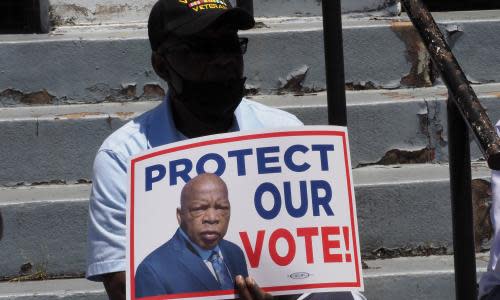Alabama electoral maps discriminate against Black voters, federal court rules

Alabama Republicans illegally discriminated against Black voters when they drew the state’s seven new congressional districts last year and must quickly redraw the plan, a federal court has ruled.
Related: The fight for federal voting rights legislation is far from over | Jared Evans
The ruling is hugely consequential, a blunt assessment of the way lawmakers use their power to draw district lines to dilute the influence of Black and other minority voters.
Pending lawsuits in North Carolina and Texas similarly allege that lawmakers illegally drew districts on the basis of race.
About a quarter of Alabama’s population is Black but there is only one congressional district in the state where Black voters make up a majority.
Plaintiffs who sued in September argued it was possible to draw a second district where Black voters made up a sizable enough portion to elect the candidate of their choice.
A three-judge panel agreed on Monday, saying the state plan probably violated section 2 of the Voting Rights Act. That provision of the law outlaws voting practices that discriminate on the basis of race.
“Black voters have less opportunity than other Alabamians to elect candidates of their choice to Congress,” Stanley Marcus, a judge on the US court of appeals for the 11th circuit, wrote for an unanimous panel.
“The appropriate remedy is a congressional redistricting plan that includes either an additional majority Black congressional district, or an additional district in which Black voters otherwise have an opportunity to elect a representative of their choice.”
Marcus, who was appointed by Bill Clinton, was joined in the opinion by Anna Manasco and Terry Moorer, both nominated by Donald Trump.
The Alabama attorney general, Steve Marshall, a Republican, said the state would appeal to the US supreme court.
The panel ordered state lawmakers to come up with a new plan in 14 days, and pushed back the deadline for qualifying for the ballot from 28 January to 11 February. If Republican lawmakers cannot come up with a new plan in that time, the court said it would appoint a special master to draw one.
The seventh congressional district in Alabama, which stretches from Birmingham to the rural Black Belt, has consistently elected a Black Democrat to Congress for 30 years. Nearly 56% of the voting-age population in the district is Black. The state’s other six districts have all been represented by white Republicans.
The plaintiffs in the case, including four voters, two state senators and several civil rights groups, argued that Alabama Republicans packed as many Black voters into the district as possible – about a third of Alabama’s Black population – in order to weaken their influence in other district across the state.
The new map also split Black communities elsewhere in the state, to dilute the influence of Black voters.
“It’s past time for Alabama to move beyond its sordid history of racial discrimination at the polls, and to listen to and be responsive to the needs and concerns of voters of color,” Tish Gotell Faulks, legal director for the American Civil Liberties Union of Alabama, said in a statement.
The case is likely to be the first redistricting case the supreme court considers in this redistricting cycle, a process which occurs once every 10 years.
While the supreme court has said it can do nothing to stop partisan gerrymandering, district plans that make it harder for minority voters to elect the candidate of their choosing remain illegal under the Voting Rights Act.
Nicholas Stephanopolous, a professor at Harvard who studies redistricting, tweeted that the case offered a “textbook” example of the kind of discrimination outlawed by the Voting Rights Act.
“If this doesn’t violate section 2, nothing does,” he said.

 Yahoo Movies
Yahoo Movies 